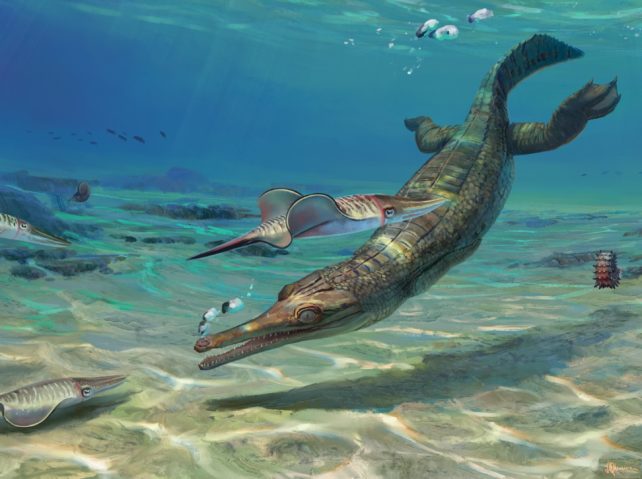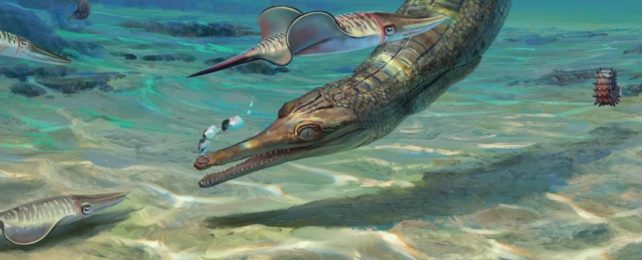In the Early Jurassic, before the mass extinction event that brought about the demise of most dinosaurs, the ancestors of crocodiles had a whole bunch of relatives living in the sea.
Researchers have found the oldest fossils yet of these ancient marine predators in the United Kingdom and Morocco. They say the remains hint at a 'ghostly' ancestor that has never been found in fossil form.
Ancient 'marine crocodiles' are known scientifically as thalattosuchians, of which numerous different species once existed. Although some thalattosuchians grew as long as 10 meters (33 feet), the newfound creature measured about 2 meters and possessed short limbs and a long, strong tail.
Their long, slender snouts resemble modern crocodiles, with enlarged jaw muscles that probably allowed them to snap up fish, octopus, or squid with impressive speed and force.
Despite their outward appearance, these long-gone marine predators are not technically part of the Crocodylia order. In fact, scientists don't really know where to place thalattosuchians in the tree of life. They could be a sister group to crocodylians, or an ancient radiation that branched off long ago.
One of the most complete skeletons of a thalattosuchian was recently unearthed in the UK. It is also the oldest example found yet, dated to around 185 million years.
The species has been named Turnersuchus hingleyae, and researchers suspect its relatives are out there waiting to be discovered.
Based on the fossil's morphology compared to other ancient crocodylians and thalattosuchians, experts think thalattosuchians' ancestors arose around 200 million years ago, toward the end of the Triassic Era. That's about the same time that ancient crocodylians are thought to have appeared themselves.
To date, no fossils have yet been found of marine crocodiles that date back to this time, but that doesn't mean they don't exist.
"I expect we will continue to find more older thalattosuchians and their relatives," says vertebrate paleontologist Eric Wilberg from Stony Brook University in New York.
"Our analyses suggest that thalattosuchians likely first appeared in the Triassic and survived the end-Triassic mass extinction."

The other thalattosuchian fossil recently found in Morocco supports this timeframe as well.
It's not as well preserved as the one in the UK, which means it can't be placed in a specific genus. That said, it is one of the only examples of a marine crocodile recovered outside of Europe, which suggests these predators were "widely distributed as soon as the earliest Jurassic".
The fossil record makes it look as though marine crocodiles simply appeared in the Early Jurassic out of nowhere, rich in diversity and spread across multiple regions, like Europe, China, Argentina, and Madagascar. But what happened, in reality, is probably more nuanced than that.
Archaeologists need to find that older ghostly lineage to find where these creatures came from. Let the hunt begin.
The fossil found in the UK was published in the Journal of Vertebrate Paleontology.
The fossil found in Morocco was published in the Journal of African Earth Sciences.
